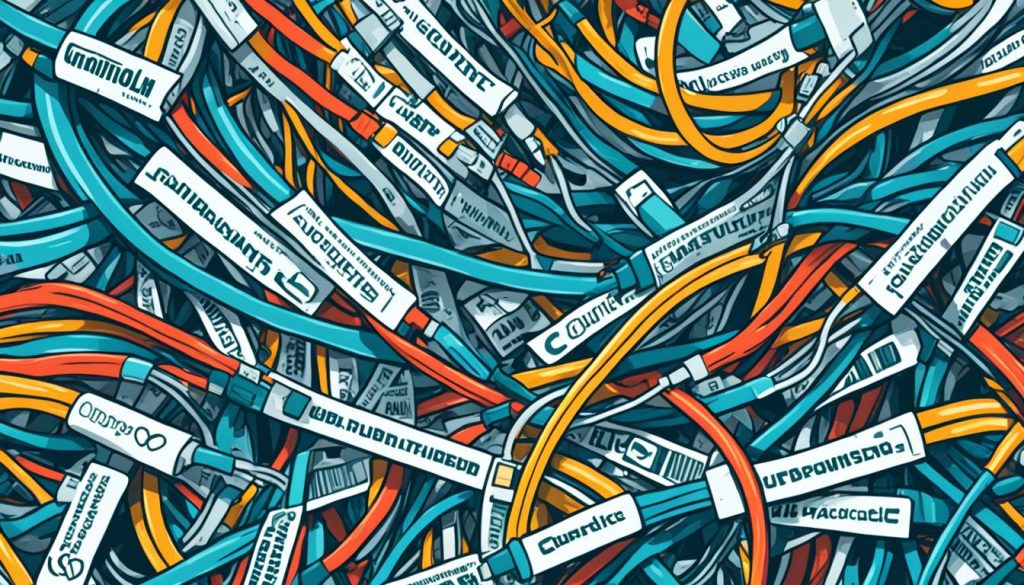In today’s world, subscription-based models are everywhere, from streaming services to software tools. We’re used to the ease and flexibility of paying as we go. But, the real cost of these subscriptions is often overlooked. It’s the growing number of services and rising prices that are hitting our wallets hard.
A 2021 report showed that 56% of people feel overwhelmed by the many streaming services out there1. J.D. Power found that households spent an average of $47 to $55 a month on streaming in the first half of 20211. This shows a trend of spending more on subscriptions. It’s because of price increases and the need to get multiple services to not miss out.
Key Takeaways
- Subscription-based models are everywhere, from streaming services to software tools.
- Consumers are feeling the financial strain of rising subscription costs and the need to subscribe to multiple services.
- The true cost of subscription models, including streaming and software, is often underestimated.
- Subscription price increases and the growing number of required services are driving the rise in subscription costs for consumers.
- Understanding the financial implications of subscription models is crucial for managing personal and household budgets.
The Rising Tide of Subscription Services
In today’s digital world, how we watch content has changed a lot. Smartphones and fast internet have made the OTT (over-the-top) streaming market grow fast. This growth is expected to keep going2. Now, people can easily watch movies, TV shows, music, podcasts, and more, whenever they want, from anywhere with internet.
Streaming Subscriptions on the Rise
More people are using digital streaming services for several reasons. These include smartphones, fast internet, and choosing what you want to watch2. This change has made more people switch from traditional TV to streaming services for its ease and variety.
Over a third (34%) of healthcare leaders are looking at new ways to pay for services to deal with money issues3. This shift to subscription services isn’t just for entertainment. It’s also happening in software, healthcare, and transport as companies try to meet what customers want.
“The transition to as-a-service models in healthcare is expected to gain further traction, indicating a growing trend towards this approach.”3
As more people want digital content, subscriptions have become the main way to get services and content. This change has changed how we enjoy media and entertainment. It has also influenced many industries, leading to new ideas and business models234.
The True Cost of Subscription Models: From Streaming to Software
Today, we all deal with many subscription payments for streaming, software, and digital services. These services offer great convenience and value, but their costs can add up quickly. This leaves many people feeling the pinch5.
The online video streaming market was worth $42.6 billion in 2019 and is growing fast, with a 20.4% annual growth rate expected from 2020 to 20275. With more people using smartphones, the demand for these services keeps rising. In India, for example, the market for online video OTT services was $638 million in 2018 and is set to hit $1.7 billion by 20235.
But, there are challenges with so many subscriptions. Consumers often end up paying for multiple services, which can be a big financial hit. This problem is worse since 89% of OTT users in India are under 355. Also, 55% of OTT users live in the top five cities, and another 36% in Tier 1 cities5.
Subscription models also affect businesses. They need to keep offering value, keep customers coming back, and handle the complex payments6.
As the subscription economy grows, both sides must find their way. They need to balance the perks of digital services with the costs of ongoing payments. Knowing the real cost of subscriptions helps people make better choices and helps businesses offer lasting and valuable services5.
Factors Driving Subscription Costs
The number of subscription services has grown a lot, giving consumers many choices. Understanding why these services cost more is key. This is because of the subscription proliferation.
Proliferation of Services
Now, we have more streaming options, which means higher costs and more expensive add-ons. With new services like Peacock and CNN coming, people need to pay for several platforms to get the shows they like7. Also, streaming services often offer many subscription choices, making people pay for things they don’t use or want7.
Consumer Loyalty and Retention Strategies
Streaming companies use consumer behavior and brand loyalty tricks to keep customers. These include automatic payments and making it hard to cancel, keeping people signed up longer than they wanted7. This means consumers might end up paying more for subscriptions they didn’t plan to keep.
The ways streaming services keep customers, like bundling and making it hard to cancel, affect the price changes people see7. These methods aim to increase brand loyalty and keep customers around. But, they can also make costs go up for users.
The growth of streaming services and smart retention tactics have made choosing subscriptions hard for consumers7. As the industry changes, knowing what drives subscription costs is key for making smart choices and managing money7.
Managing Subscription Overload
In today’s world, it’s easy to get swamped by all the monthly fees from subscription services. From streaming platforms to software, managing many subscriptions can strain your budget and sanity. Luckily, there are ways to take back control and make your subscription management better.
Organizing and Consolidating Subscriptions
Start by checking all your subscriptions. Look at your bank and credit card statements to see all the recurring charges. Once you know what you’re paying for, it’s time to simplify. Use one payment method for all subscriptions to make tracking and canceling easier8.
Then, find subscriptions that do the same thing. For instance, if you have Netflix and Hulu, you might cancel one and stick with the other. Always check your subscriptions and drop the ones you don’t use or value8.
Set reminders for when free trials end to avoid extra charges. This way, you won’t pay for services you don’t want or need8.
Leveraging Free Trials and Rotating Subscriptions
Many services offer free trials, letting you try before you buy. Use these to check out new services without extra costs. But, make sure to watch for when the trial ends to avoid extra charges.
Rotating your subscriptions is another way to save money. Instead of having many subscriptions at once, switch them out over time. This lets you save money and always find new things to enjoy8.
This method takes more time to manage, but it can save a lot of money. By using free trials and rotating subscriptions, you can pick the services you like best without spending too much.
In conclusion, managing subscription overload is key in today’s digital world. By organizing your subscriptions, using free trials, and rotating services, you can control your monthly costs. This way, you can enjoy your subscriptions without the stress of too many expenses8.
Conclusion
The digital world is always changing, making it tough for consumers to handle the rising costs and many subscription services9. Services like Netflix and Twitch have millions of users, showing how common subscriptions have become9. Now, subscriptions are used in many areas, from streaming to software.
But, this growth brings problems. Fraudsters target subscription services, causing losses for companies, artists, and distributors10. To deal with this, people need to keep their subscriptions in order, combine services, and use free trials and rotating memberships to save money.
As technology changes, it’s important for consumers to be careful and make smart choices about what subscriptions to keep11. With more live sports streaming in China and new digital taxes worldwide1110, subscription models will keep changing. Consumers need to keep up with trends and make choices that fit their needs and budgets.
FAQ
What did the 2021 CTV Growth Opportunity Report find about the number of streaming services available?
How has the average household monthly spending for streaming services changed?
What are consumers’ concerns about their spending on streaming services?
What factors are driving the rise in streaming costs for consumers?
What factors are contributing to the growing popularity of digital streaming services?
What is online digital streaming fraud and what are the factors driving its rise?
How are the wealth of streaming options and the proliferation of services affecting consumer costs?
What strategies can consumers use to manage subscription overload?
Source Links
- Sift is building a better platform for analyzing hardware telemetry data | TechCrunch
- Five reasons why healthcare providers are adopting as-a-service models in patient monitoring
- 10-K Document 2023
- The Behaviour of Consumers towards Subscriptions to Online Streaming Applications
- Lawhive raises $12M to expand its legal tech AI platform for small firms | TechCrunch
- Hollywood is paying a steep price for never really figuring out the streaming model
- Google Data Analytics Professional Certificate Answers – Coursera
- Effects of Video Game Streaming on Consumer Attitudes and Behaviors
- Digital Taxation around the World
- Can signal delay and advertising lead to profit? A study on sporting



